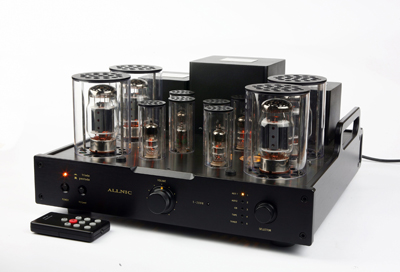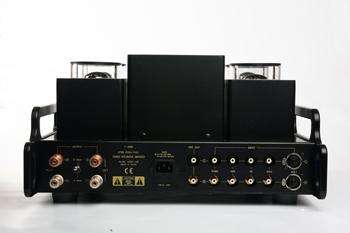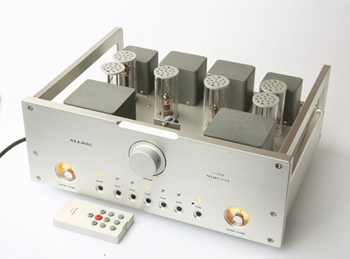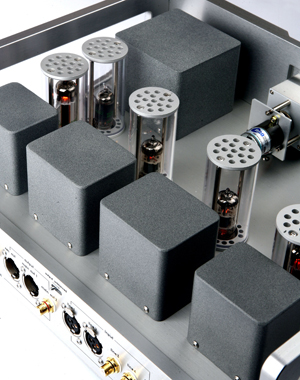| 21st Century Tube Technology - Revised |
by
Ernie Fisher
 Ever since I took a look and listen to the entry-level Allnic
preamplifier, my perspective changed from a casual to a formal
interest. It wasn’t because of the unit’s retro
look — which I like — it was because it sounded
good and offered superb build and parts quality. Allnic Audio
is likely named for its use of a pure nickel alloy core in
its transformers. It is a family-owned business located in
South Korea headed by Kang Su Park. I understand that the
family’s participation in the manufacturing process
is the basis to guarantee a product that goes beyond standard
quality control procedures and include carefully chosen parts,
testing these components within the sphere of circuitries
and wiring and assembling them meticulously by hand. Ever since I took a look and listen to the entry-level Allnic
preamplifier, my perspective changed from a casual to a formal
interest. It wasn’t because of the unit’s retro
look — which I like — it was because it sounded
good and offered superb build and parts quality. Allnic Audio
is likely named for its use of a pure nickel alloy core in
its transformers. It is a family-owned business located in
South Korea headed by Kang Su Park. I understand that the
family’s participation in the manufacturing process
is the basis to guarantee a product that goes beyond standard
quality control procedures and include carefully chosen parts,
testing these components within the sphere of circuitries
and wiring and assembling them meticulously by hand.
My original intention was to review the T-2000 separately,
but I changed my mind because the L-3000 preamplifier arrived
shortly after the integrated amplifier and I used both for
this evaluation as well as for the reviews of the Genesis
power amp and the Focal loudspeakers.
I first operated the T-2000 as an integrated amplifier, although
it can be used as a stand-alone stereo power amp, or part
of a bi-amplified system. The unit provides in and outputs
to accommodate either application. Additionally, it can be
operated in pentode and triode modes, controllable via a front-mounted
toggle switch while the amp is on. I connected my CD playback
system directly to the unit and began listening, switching
between pentode and triode modes frequently.
To evaluate the L-3000 preamplifier’s performance with
different amplifier designs, I used it with the Genesis Reference
Amplifier, the Bryston 7B SST Squared, the BelCanto monoblocks
and its sibling the T-2000.
The Sound
 First impressions are usually pretty good indicators of
what’s to come and my first reflections were that
the amp sounded engaging, pleasant and musical. Switching
between the triode and pentode modes resulted in slight
changes whereby in triode operation, the T-2000 sounded
somewhat softer at frequency extremes but firmer with
better resolution in the pentode mode. However, the amplifier’s
primary sonic signature remained unchanged, which brings
me to the important part of the evaluation. As indicated
earlier, the T-2000’s overall sound quality is that
of a powerful, but well tempered instrument, always calm
and in control of the music’s enormous dynamic changes
and frequency swings. Mellifluous, blossoming top frequencies
blend effortlessly with the entire midrange band and continue
smoothly into the bass regions. I liked what I heard,
but missed the touch of detail, the decisive focus and
image on the sound stage — resolution. I connected
my Dolan preamplifier and, now with the T-2000 in the
bypass mode, listened again. Wow, with the preamplifier
in the setup, the amplifier provided the sonic element
described above but now with resolution across the entire
frequency reach, really actually finishing what was earlier
unfinished. With the preamplifier in the system, the gain
control on the amplifier isn’t bypassed thereby
allowing functional remote access to volume and mute. First impressions are usually pretty good indicators of
what’s to come and my first reflections were that
the amp sounded engaging, pleasant and musical. Switching
between the triode and pentode modes resulted in slight
changes whereby in triode operation, the T-2000 sounded
somewhat softer at frequency extremes but firmer with
better resolution in the pentode mode. However, the amplifier’s
primary sonic signature remained unchanged, which brings
me to the important part of the evaluation. As indicated
earlier, the T-2000’s overall sound quality is that
of a powerful, but well tempered instrument, always calm
and in control of the music’s enormous dynamic changes
and frequency swings. Mellifluous, blossoming top frequencies
blend effortlessly with the entire midrange band and continue
smoothly into the bass regions. I liked what I heard,
but missed the touch of detail, the decisive focus and
image on the sound stage — resolution. I connected
my Dolan preamplifier and, now with the T-2000 in the
bypass mode, listened again. Wow, with the preamplifier
in the setup, the amplifier provided the sonic element
described above but now with resolution across the entire
frequency reach, really actually finishing what was earlier
unfinished. With the preamplifier in the system, the gain
control on the amplifier isn’t bypassed thereby
allowing functional remote access to volume and mute.
For the next listening test, I inserted the Allnic L-3000
preamp in a system with the Genesis 5.3 loudspeakers. With
the T-2000/L-3000 arrangement driving the midrange and high
frequency drivers, the overall sound wasn’t just great,
I was magnificent. The speakers’ ribbons, designed
to handle high frequencies, took on vivacity and verve,
though well controlled and smooth as a baby’s. The
entire midrange segment (from 160Hz to about 1300Hz) became
vibrant, almost animated for it showed clearly the spaces
where instruments and voices are located on the sound stage.
Loads of air, great detail and focus, amazingly real rendering
of tonal shades and a harmonious balance of it all made
listening an encounter with music to behold.
 I connected the L-3000 preamp (a fully balanced design)
in the balanced mode to the earlier reviewed Genesis power
amplifier (also fully balanced) and, again, became more
enthralled and more engaged with the music than in any other
earlier listening tests. This pointed directly to the L-3000’s
presence in the Genesis amplifier/speaker set-up and I couldn’t
wait to hear another system combination. For the next audition,
I got down on my knees behind my stand, connected the preamp
in a system with the Genesis 5.3 speakers driven by the
Bryston 7B SST Squared monoblocks. At first I used the single-ended
connection (with RCA termination), but later changed it
to the balanced mode (with XLR) as the Brystons are also
fully balanced designs. My knees were aching, but my ears
were pleased as I listened to the 3rd movement of Beethoven’s
5th. I have listened to this CD (a JVC with Fritz Reiner
conducting the Chicago symphony) for many years, but I have
never heard it as utterly real as it was in this system.
I heard more; more staging, more resolution, more tonal
blossoming, sweeter highs and greater musical fiber across
the important midrange; and I clearly perceived the system’s
control over the signal’s dynamics. Beethoven’s
5th shocks for its fortissimo punches and fascinates for
its sensitive pianissimo passages; and this system — thanks
to the L-3000 — performed in accordance with the nature
of the signal, as it never had with any other preamplifier
I had used in the past three years. The balanced configuration
provided that certain something that completed and brought
about the best possible sound. A pair of BelCanto monoblocks
came in time for another interesting audition. I connected
the L-3000 when the amps had first arrived and gave it a
quick listen. It was good, but I waited for about one week
for the main auditioning sessions. The BelCanto/Allnic combination
worked very well. The L-3000 faithfully relayed the speed
of the amps, showed that they can sound wonderfully smooth
at top frequencies, clear and airy in the mids and provide
great bass with a surprising melodic element. For more of
this, I will have to steer you to the soon-to-come review
of the BelCanto Amps. The L-3000 worked well in all systems,
though if I had to pick one over another I would likely
choose the Genesis amp/Allnic pre system. Second place goes
to Bryston/Allnic connected in balanced mode. Third place
has to be the Allnic/Allnic combo, not because it was merely
good, but because of the added charm and sweetness provided
by the tube design. The BelCanto/Allnic combo was perhaps
the one that showed top accuracy, great resolution across
the audible frequency reach, excellent detail and enough
harmonic elements to hear into the music on a multi-dimensional
sound stage. The musicality element of this combination
wasn’t as pleasing as the all Allnic system, but it
did offer better resolution. I connected the L-3000 preamp (a fully balanced design)
in the balanced mode to the earlier reviewed Genesis power
amplifier (also fully balanced) and, again, became more
enthralled and more engaged with the music than in any other
earlier listening tests. This pointed directly to the L-3000’s
presence in the Genesis amplifier/speaker set-up and I couldn’t
wait to hear another system combination. For the next audition,
I got down on my knees behind my stand, connected the preamp
in a system with the Genesis 5.3 speakers driven by the
Bryston 7B SST Squared monoblocks. At first I used the single-ended
connection (with RCA termination), but later changed it
to the balanced mode (with XLR) as the Brystons are also
fully balanced designs. My knees were aching, but my ears
were pleased as I listened to the 3rd movement of Beethoven’s
5th. I have listened to this CD (a JVC with Fritz Reiner
conducting the Chicago symphony) for many years, but I have
never heard it as utterly real as it was in this system.
I heard more; more staging, more resolution, more tonal
blossoming, sweeter highs and greater musical fiber across
the important midrange; and I clearly perceived the system’s
control over the signal’s dynamics. Beethoven’s
5th shocks for its fortissimo punches and fascinates for
its sensitive pianissimo passages; and this system — thanks
to the L-3000 — performed in accordance with the nature
of the signal, as it never had with any other preamplifier
I had used in the past three years. The balanced configuration
provided that certain something that completed and brought
about the best possible sound. A pair of BelCanto monoblocks
came in time for another interesting audition. I connected
the L-3000 when the amps had first arrived and gave it a
quick listen. It was good, but I waited for about one week
for the main auditioning sessions. The BelCanto/Allnic combination
worked very well. The L-3000 faithfully relayed the speed
of the amps, showed that they can sound wonderfully smooth
at top frequencies, clear and airy in the mids and provide
great bass with a surprising melodic element. For more of
this, I will have to steer you to the soon-to-come review
of the BelCanto Amps. The L-3000 worked well in all systems,
though if I had to pick one over another I would likely
choose the Genesis amp/Allnic pre system. Second place goes
to Bryston/Allnic connected in balanced mode. Third place
has to be the Allnic/Allnic combo, not because it was merely
good, but because of the added charm and sweetness provided
by the tube design. The BelCanto/Allnic combo was perhaps
the one that showed top accuracy, great resolution across
the audible frequency reach, excellent detail and enough
harmonic elements to hear into the music on a multi-dimensional
sound stage. The musicality element of this combination
wasn’t as pleasing as the all Allnic system, but it
did offer better resolution.
Synopsis
 Just when I thought I had finally finished this essay, the
Tenor 175 S stereo amplifier arrived and I connected it
to the Allnic L-3000. Having had the preamp in use for
a few weeks and with various components, I had become
very well acquainted with its sonic personality. However,
I was not prepared for the sonic impact, this system combination
provided. By introducing the ultra high-end Tenor power
amp to the system, its musical value shot up tremendously.
Earlier auditions of the Tenor monoblocks had familiarized
me with the amp’s sonic character and I expected
really good sound. Well, I got it; I recognized the amp’s
signature immediately, which can only mean that the L-3000
has a high level of neutrality. In musical terms, the
system left nothing incomplete or unfinished and illustrated
two points: the preamplifier is well suited for high-end,
highly resolving components; and its own sonic signature
is not adding or imposing damaging deteriorating elements.
The bottom line: I believe that the price/performance
ratio is on the button and one gets what one paying for.
The somewhat retro look of the Allnic line reminds me
of the old days of classic audio designs, making these
components visually unique — a delight for audiophile
eyes — and a treat for discerning ears. Just when I thought I had finally finished this essay, the
Tenor 175 S stereo amplifier arrived and I connected it
to the Allnic L-3000. Having had the preamp in use for
a few weeks and with various components, I had become
very well acquainted with its sonic personality. However,
I was not prepared for the sonic impact, this system combination
provided. By introducing the ultra high-end Tenor power
amp to the system, its musical value shot up tremendously.
Earlier auditions of the Tenor monoblocks had familiarized
me with the amp’s sonic character and I expected
really good sound. Well, I got it; I recognized the amp’s
signature immediately, which can only mean that the L-3000
has a high level of neutrality. In musical terms, the
system left nothing incomplete or unfinished and illustrated
two points: the preamplifier is well suited for high-end,
highly resolving components; and its own sonic signature
is not adding or imposing damaging deteriorating elements.
The bottom line: I believe that the price/performance
ratio is on the button and one gets what one paying for.
The somewhat retro look of the Allnic line reminds me
of the old days of classic audio designs, making these
components visually unique — a delight for audiophile
eyes — and a treat for discerning ears.
Commentary
The longer I listen to evaluate audio components, the harder
it is to relax, unless of course, the playback system
is emphasizing the musical experience and not the components’ presence.
When I feel that the audio gear is the means, but not
the focus for the enjoyment of music, I fish out my old
recordings, sit back and listen for hours. And that is
exactly what happened during the time I worked on this
essay. For the auditions I used my Ethera Vitae, the Focal
and the Reeve Design Loudspeakers as well as the Genesis
5.2s. With the Bryston, Genesis, Allnic and BelCanto power
amplifiers and thus, came up with sixteen system combinations.
That’s sixteen multiplied by an average of five
hours per system or a total of 80 hours of auditioning.
Add to this a few days, when I simply enjoyed listening
to my favourite tunes, and I’d say I became intimately
familiar with the components’ sonic disposition — solo
and in systems. The various sonic attributes gained by
randomly connecting the components showed again that system
synergy can and will bring about the desired audio effects;
and by extension making it possible to come up with sound
that best suits the listener. My choices regarding first,
second, third and fourth place are what I preferred as
another audio enthusiast and, as such, I would be very
happy to live with any one of the systems.
*NEW: The
Allnic T-2000: A Second Opinion by David McCallum |
| MODELS |
MANUFACTURER |
| Allnic Audio Integrated Amplifier Model T-2000 & L-3000
Preamplifier |
Hammertone Audio |
| RATING |
CONTACT |
T-2000: ♪♪♪♪
L-3000: ♪♪♪♪
|
www.hammertoneaudio.com |
| PRICE |
T-2000: $8,900.00
L-3000: $10,9000.00
|
| Dimensions: T-2000 |
(W x D x H) 430mm
x 430mm X
240mm
Weight:
40Kg |
| Dimensions: L-3000 |
|
(W x D x H) 430mm × 350m) × 173mm
Weight:
17 kg |
|
 |
TECHNOLOGY
I’d like to touch upon the tech part in a very casual
manner, as my main interest is the components’ sound
quality. As the Allnic’s sound is rather high-end,
one can take it for granted that the technology behind the
sound is not the same as one finds in mass-market electronics.
It all begins with careful selection of parts and the skill
to utilize them in the engineering and assembling process.
Allnic’s design highlights are interesting, though
not necessarily unique.
The L-3000 preamplifier features a single gain stage circuit
that uses only one tube in the amplification. Allnic’s
aim is to achieve “purer, more detailed, more spacious
and more dynamic sound” than the alternative — a
multi gain stage design. The important transformer is made
with a large pure nickel alloy and it functions here coupled
as a line output device. The usual (and cheaper) method
is capacitor coupling. This method transmits only voltage,
rather than real watts possible with transformer-coupling
technology which functions at 90% efficiency, limiting the
energy loss to only about 10%. Combined with Allnic’s
careful selection of vacuum tubes, the preamp achieves exemplary
wide bandwidth and low distortion. The L-3000 has constant
150 ohms output impedance at all frequencies, thus providing
signal stability for the power amplifier, especially in
the low frequency domain. Allnic designed an ultra high-speed
automatic voltage regulator that protects the amplifying
tubes from any AC line changes and deals with all current
demands.
The unit has an automatic muting system
that delays powering
up for about 40 seconds to prevent any harmful transients
to power amplifier
and to loudspeakers while it is warming
up.
A couple of illuminated analog current meters
show
the status of L-3000's operation and any failure or any
damages in parts will move the needle off the mark.
A
patented "Absorb GEL tube damper" design prevents
vibration or microphonic noise to enter the audible range.
There is a simple remote control that allows access to volume,
mute, input and standby. It activates a precision analogue
attenuator via an oil clutched motor. The main power switch
is on the unit’s left while on its rear provides two
balanced and three unbalanced inputs and one balanced and
on unbalanced output.
The L 3000’s specifications hint at the unit’s
quality. The input impedance is 10kΩ;
its frequency
range is from 20Hz to 20kHz (flat), and from
16Hz to 75kHz
(-3dB);
voltage gain is +20dB; THD (1kHz) at output of
0.3V is 0.06%;
output at 1.0V is 0.15%;
S/N ratio is
-90dB (CCIR, 1kHz); maximum output is15V RMS (non clipping)
; output Impedance is150Ω constant. Vacuum tubes
used are
E810F × 2 , 7233 × 2, 6485 × 2
(voltage regulator). The unit’s dimension are 430mm(W) × 350mm(D) × 173mm(H)
and it weighs17 kg (about 38 pound).
The T-2000 stereo integrated amplifier is one of Allnic
Audio’s two KT120 stereo integrated amplifier models.
Like all Allnic Audio products, the T-2000 has Permalloy
(iron and nickel alloy) for its transformer cores. Allnic
is grateful to Mr. G.W. Elmen of Western Electric for inventing
Permalloy for transformer core use. The T-2000 delivers
70 watts/channel in a push-pull, triode/pentode switchable
mode. Remote controlled 41 steps silver contact attenuator.
The T-2000 employs an in-house made 41 step, silver contact
quality attenuator, instead of a commonly used carbon film
potentiometer. The attenuator provides complete channel
balance and minimum distortion. The T-2000 uses only two
stages of driving circuit to achieve +35dB of voltage gain
(three or four stages are common in many conventional integrated
amplifiers). This results in much lower coloration and increased
speed in signal/sound reproduction. The D3a is used in triode
mode as the second stage driver tube, with a load of about
5 kohms, and using 20mA of current.
Allnic's "Full Engagement" transformers boast
four independent, secondary windings which are always fully
connected, never "idled". This means that all
secondary windings are always connected to your loudspeakers,
regardless of which output switch position you use (4 ohms,
8 ohms or 16 ohms, depending on the factory configuration
you have selected). Thus, the transformer output efficiency
is unparalleled.
Allnic uses very large output transformers (96 mm) with
nickel, mixed with FeSi, cores. This provides for higher
inductance with fewer windings than more conventional designs
and achieves an extremely wide range of output frequencies.
The T-2000 has soft start circuitry that, after sufficient
warm-up only, provides the high voltage supply to the plate
of each tube. This (protective) design results in prolonged
tube life and fewer and less frequent issues with tube performance.
In order to provide constant current (bias) monitoring for
the power tubes, Allnic uses a separate analogue current
meter for each tube. The meters make it easy to see the
status of each tube at any time and to respond immediately
to any variation in bias, adjustable via the bias control
knob for the relevant tube. Switching between triode and
pentode operation can be done "on-the-fly" at
any time while the amplifier is in use.
T-2000 specifications:
Output Power: 70w + 70w (8 Ω load,
at 1KHz); distortion is 0.2% at 1KHz, 2.83V; frequency response
is from 20Hz - 20KHz flat; S/N Ratio is -80dB (CCIR, 1KHz);
damping factor is 7 at 8 ohm load at 1KHz; voltage gain
is +35dB; input impedance is 10K ohm (single-ended, unbalanced);
input sensitivity is 400mV for rated power. Tubes: KT120
X 4 (power triode)
D3a X 4 (2nd stage driver tube – no
equivalent)
6485
X 4 (1st stage driver: similar
to 6AH6, 6AH6WA, 6AH6S,
CV2521).
Fuses: AC Mains - 3A / 250V (110W) (two
supplied – one
is a spare). Tubes -
0.5A, 250V, 20mm glass type
|
|
